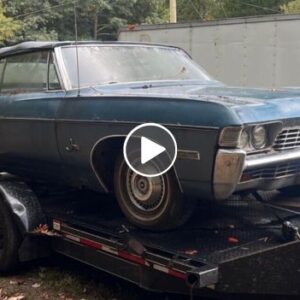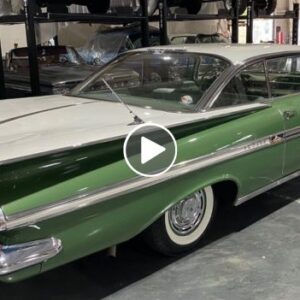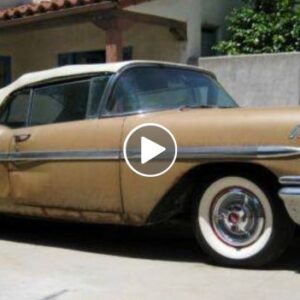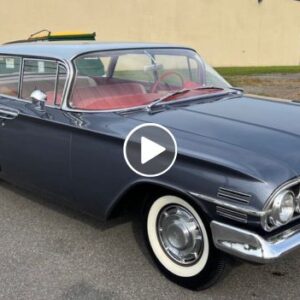The 1970 Plymouth Superbird replica featured in this article is a force to be reckoned with, boasting a twin-turbo 572 ci HEMI V8 engine that was meticulously crafted by Nelson Racing Engines. This awe-inspiring all-aluminum motor is equipped with an Indy block, Callies forged crank, Oliver billet rods, JE forged pistons, Indy heads, Anteater intake manifold, a dry sump system, and two water-to-air intercoolers. Its dual fuel system allows it to unleash an astonishing 1300 horsepower when fueled with race fuel. Accompanying this powerful engine is a 4L80E four-speed automatic transmission with a Compushift TCU, ensuring seamless gear shifts and optimal performance.

Dominating Performance: Engine and Powertrain Specifications
Under the hood of the 1970 Plymouth Superbird replica lies the heart of a true beast. Let’s delve into the impressive specifications that make this muscle car a force to be reckoned with:

Engine Specifications
The twin-turbo 572 ci HEMI V8 engine is the epitome of power and performance. Here are the notable components that contribute to its extraordinary capabilities:
- Indy block: The engine features an Indy block, known for its robustness and durability. It forms the foundation for the power generated by the massive HEMI V8.
- Callies forged crank: A Callies forged crankshaft ensures exceptional strength and reliability, even under the most demanding driving conditions.
- Oliver billet rods: These precision-engineered rods provide increased strength and reduce rotational weight, allowing the engine to rev higher and deliver explosive power.
- JE forged pistons: The JE forged pistons are designed to withstand extreme pressures and temperatures, making them ideal for maximizing performance in a high-powered engine like this.
- Indy heads: The Indy heads are renowned for their efficient airflow and optimal combustion, enhancing the engine’s power output and overall efficiency.
- Anteater intake manifold: The Anteater intake manifold optimizes air intake and fuel distribution, further boosting the engine’s performance potential.
Power and Transmission
To harness the immense power generated by the twin-turbo 572 ci HEMI V8, the Superbird replica is equipped with a 4L80E four-speed automatic transmission. This transmission, coupled with a Compushift TCU (Transmission Control Unit), ensures seamless gear changes and precise control over power delivery.

Unmatched Performance and Handling: Chassis and Suspension
The 1970 Plymouth Superbird replica’s performance isn’t limited to its exceptional engine. The vehicle’s chassis and suspension systems are equally impressive, providing a thrilling driving experience:
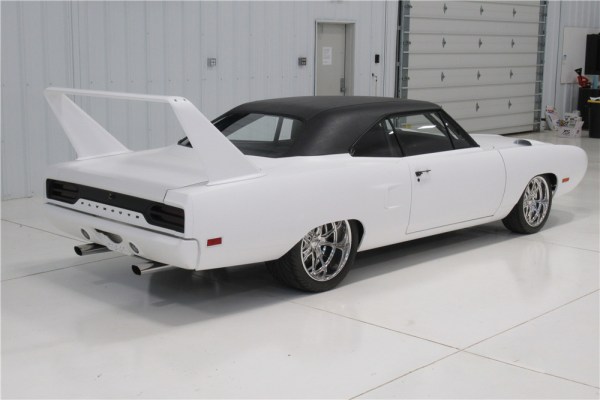
Art Morrison MaxG Chassis
The Superbird replica rides on an Art Morrison MaxG chassis, known for its exceptional rigidity and performance. This chassis provides a solid foundation, allowing the vehicle to handle the immense power with confidence and stability.
C6 Corvette Front Suspension
For improved handling and precise steering, the Superbird replica incorporates a C6 Corvette front suspension. This suspension system enhances cornering ability and ensures a smooth ride, even during aggressive maneuvers.

Triangulated 4-Link Rear Suspension
To maximize traction and maintain stability during acceleration, the Superbird replica utilizes a triangulated 4-link rear suspension. This suspension setup helps keep the rear wheels planted firmly on the ground, allowing for improved power transfer to the pavement.
Stopping Power and Style: Wheels and Brakes
The 1970 Plymouth Superbird replica strikes a perfect balance between performance and aesthetics. Here’s a closer look at its wheels and brakes:
Budnik Wheels
Enhancing the Superbird replica’s visual appeal are a set of Budnik wheels, sized 18×8 at the front and 20×12 at the rear. These custom-designed wheels not only complement the car’s classic design but also offer lightweight construction for improved performance.

Wilwood Six-Piston Calipers
The Superbird replica’s braking system is equipped with Wilwood six-piston calipers gripping onto 13-inch rotors. This setup ensures impressive stopping power, allowing for confident deceleration even during high-speed driving.
Conclusion
The 1970 Plymouth Superbird replica with a twin-turbo 572 ci HEMI V8 is a testament to automotive excellence. From its awe-inspiring powertrain to its well-engineered chassis and suspension, every aspect of this car is designed to deliver an unforgettable driving experience. Whether you’re an enthusiast or simply appreciate the combination of classic design and modern performance, the Superbird replica is sure to leave you captivated.

1. What is the horsepower output of the twin-turbo 572 ci HEMI V8 in the 1970 Plymouth Superbird replica? The twin-turbo 572 ci HEMI V8 engine in the Superbird replica generates an astonishing 1300 horsepower when fueled with race fuel.
2. What type of transmission does the 1970 Plymouth Superbird replica have? The Superbird replica is equipped with a 4L80E four-speed automatic transmission with a Compushift TCU (Transmission Control Unit).
3. What is the chassis used in the 1970 Plymouth Superbird replica? The Superbird replica features an Art Morrison MaxG chassis, known for its rigidity and performance capabilities.
4. Does the Superbird replica have a limited-slip differential? Yes, the Superbird replica is equipped with a limited-slip differential in its custom Currie 9-inch rear end.
5. What size are the wheels on the 1970 Plymouth Superbird replica? The Superbird replica sports Budnik wheels, with 18×8 size at the front and 20×12 size at the rear, adding to its stylish appearance and performance.
